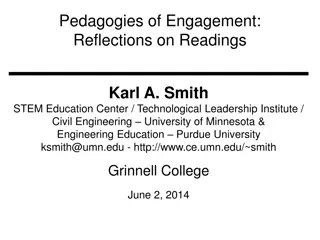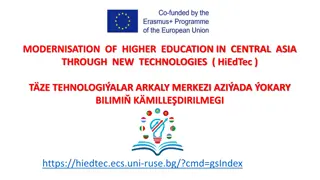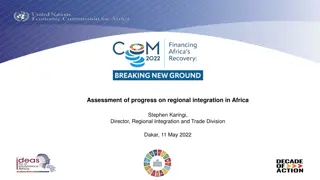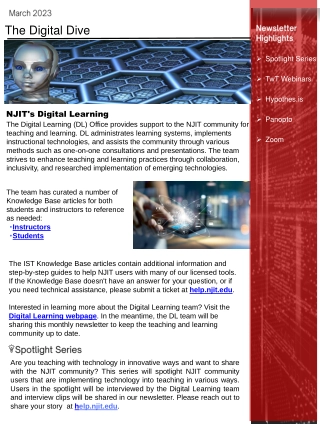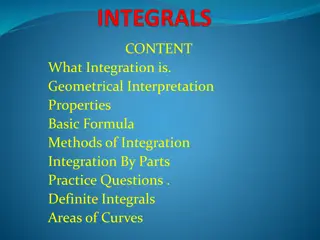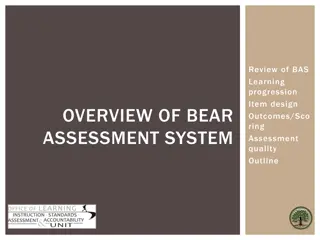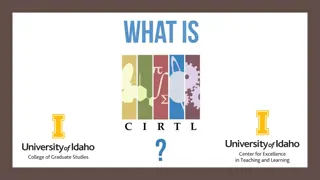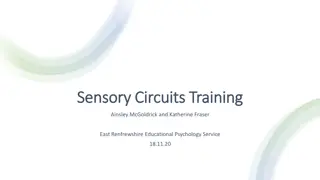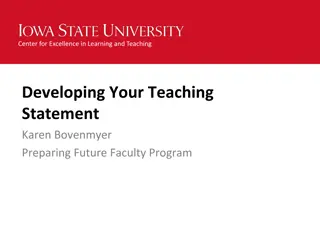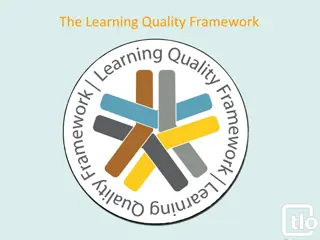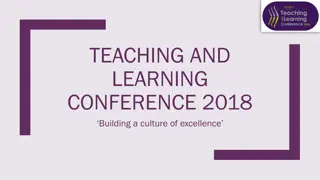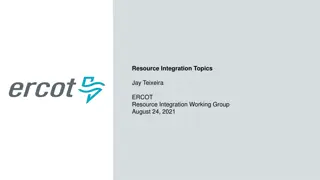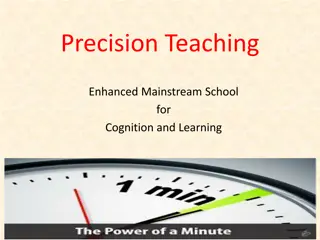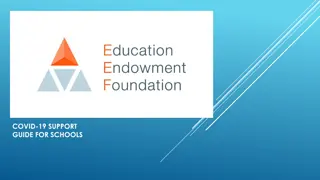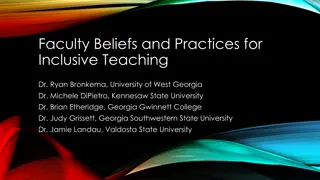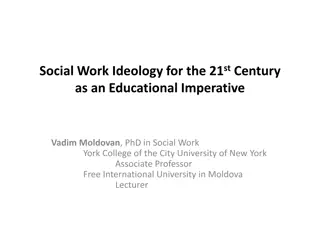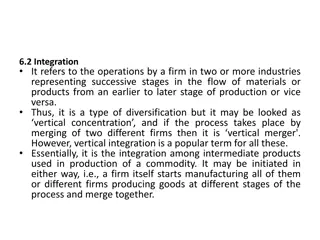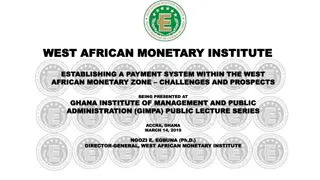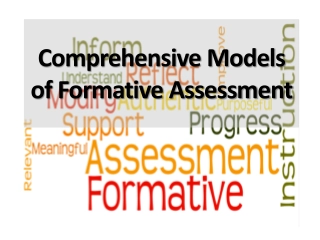Integration of Technologies in Teaching, Learning, and Assessment for Innovative Pedagogies
Explore the importance of integrating technologies in teaching, learning, and assessment to foster innovative pedagogies. Learn about the definition of learning, how technology facilitates learning, and available technologies at NUST. Understand the concept of learning as a change in behavior due to personal and environmental interactions, enabling individuals to adapt and grow. Discover varied perspectives on the learning process and its impact on behavior and experiences.
- Technologies in Education
- Innovative Pedagogies
- Teaching and Learning
- Assessment Strategies
- Learning Process
Download Presentation

Please find below an Image/Link to download the presentation.
The content on the website is provided AS IS for your information and personal use only. It may not be sold, licensed, or shared on other websites without obtaining consent from the author. Download presentation by click this link. If you encounter any issues during the download, it is possible that the publisher has removed the file from their server.
E N D
Presentation Transcript
Integration of technologies in Teaching, Learning and Assessment (TLA) to promote innovative pedagogies By Maurice Nkusi Acting Director: Teaching and Learning Unit E-mail: mnkusi@nust.na
Do what you can with what you have and where you are. Theodore Roosevelt Education is what remains after one has forgotten what one has learned in school. Albert Einstein Tell me and I forget. Teach me and I remember. Involve me and I learn. Benjamin Franklin He who learns but does not think, is lost! He who thinks but does not learn is in great danger. Confucius
1. Learning at the Glance 2. Technology Facilitating Learning 3. Available Technologies at NUST
Questions What is learning? When teaching, are students really learning? What is the technology in facilitating learning
Learning at the Glance 1. What is learning? Learning involves change where it deals with the acquisition of habits, knowledge and attitudes. Learning enables the individual to make both personal and social adjustments. Since the concept of change is inherent in the concept of learning, then any change in behaviour implies that learning is taking place or has taken place. Learning that occurs during the process of change can be referred to as the learning process. (Crow & Crow, 1963, p.1)
Learning at the Glance Cont. 2. What is learning? Cont. Learning is a change in the individual, due to the interaction of that individual, and his environment, which fills a need and makes him more capable of dealing adequately with his environment. (Burton, 1963, p.7) 3. What is learning? Cont. There is a remarkable agreement upon the definition of learning as being reflected in a change in behaviour as the result of experience. (Haggard, 1963, p.20)
Learning at the Glance Cont. 4. What is learning? Cont. Learning is the process by which an activity originates or is changed through reacting to an encountered situation, provided that the characteristics of the change in activity cannot be explained on basis of native response tendencies, maturation, or temporary states of the organism (e.g. fatigue, drugs, etc.). (Hilgard & Bower, 1966, p.2)
Conclude with Defining Learning Contemporary learning theorists see learning as a process by which behaviour is changed, shaped, or controlled. Others theorists prefer to define learning in terms of growth, development of competencies, and fulfillment of potentials. Learning relates to experience (experiential learning). It has a quality of personal involvement the whole person in both his feeling and cognitive aspects being in the learning event; this is self-initiated. When learning is achieved, the learner is the first to know. The sense of discovery, of reaching out, of grasping and comprehending come from within. It is very critical to activate students to express what is within after a learning process and feeling of growth. This is where reflective thinking comes in.
Strategic Questioning Leading to Reflective Thinking Question: When buying an electronic device, you always get a book containing instructions about the device. Do you read the book before you use the device or you start using the device and read the book if you have a question and you need answers? Teaching Method Need to Know Many educators ignore this basic learning model and spend most of class time providing information (answers) and then ask questions in the form of a quiz, test, or discussion. This is backward. Many students cannot learn this way. It is simply too hard to understand, organize, interpret, or make sense out of information - - or even to care about it -- unless it answers a question that students care about.
Strategic Questioning Leading to Reflective Thinking cont. Lessons, units, and topics are more motivating when they begin with a question that challenges students and instil them to be curious and want answers. Not only do great questions generate interest, they also answer the question that so many students wonder about: "Why do I have to learn this?" Finally, great questions increase cognitive organization of the content by framing it into a meaningful answer to the opening question. Doing so, introducing student to critical and creative thinking become more relevant from the start.
Strategic Questioning Leading to Reflective Thinking cont. What is Reflective Thinking? RT is a part of the critical thinking process referring specifically to the processes of analysing and making judgments about what has happened. Dewey (1933) suggests that reflective thinking is an active, persistent, and careful consideration of a belief or supposed form of knowledge, of the grounds that support that knowledge, and the further conclusions to which that knowledge leads. Learners are aware of and control their learning if they actively participate in reflective thinking assessing what they know, what they need to know, and how they bridge that gap during learning situations.
Strategic Questioning Leading to Reflective Thinking cont. What is Critical Thinking? Cont. CT is the use of cognitive skills or strategies that increase the probability of a desirable outcome. CT is the thinking that is purposeful, reasoned and goal directed. CT is the kind of thinking involved in solving problems, formulating inferences, calculating likelihoods, and making decisions when the thinker is using skills that are thoughtful and effective for the particular context and type of thinking task. CT is sometimes called directed thinking because it focuses on a desired outcome. (Halpern, 1996)
Strategic Questioning Leading to Reflective Thinking cont. Thinking About our Thinking - Metacognition Metacognition is about knowing more about our own thinking processes and being able to monitor and control them. Critical thinking must involve some amount of metacognition, because we need to become aware of our own reasoning, and find ways to improve them. Becoming a good and effective thinker is not just a matter of learning logic or other principles of reasoning. It also requires insight into our own minds, understanding our strengths and weaknesses. It is also important to obtain some understanding of human psychology, such as the typical cognitive biases that might influence our decisions.
Strategic Questioning Leading to Reflective Thinking cont. Thinking About our Thinking Metacognition cont. Therefore a disciplined and reflective mindset is very important for improving thinking. The development of this kind of metacognitive thinking is very often given very little emphasis in the teaching and learning of critical thinking. We suggest that the study of critical thinking should be understood as one aspect of the enhancement of metacognition.
Strategic Questioning Leading to Reflective Thinking cont. Thinking About our Thinking Metacognition cont. Therefore a disciplined and reflective mindset is very important for improving thinking. The development of this kind of metacognitive thinking is very often given very little emphasis in the teaching and learning of critical thinking. We suggest that the study of critical thinking should be understood as one aspect of the enhancement of metacognition.
Strategic Questioning Leading to Reflective Thinking cont. Thinking About our Thinking Metacognition cont. Exercise 1. A bat and a ball cost N$15.00 in total. The bat costs N$10.00 more than the ball. How much does the ball cost? Answer: N$ 2.50 2. If it takes 5 machines 5 minutes to make 5 widgets, how long would it take 100 machines to make 100 widgets? Answer: 5 minutes 3. In a lake, there is a patch of lily pads. Every day, the patch doubles in size. If it takes 48 days for the patch to cover the entire lake, how long would it take for the patch to cover half of the lake? Answer: 47 days




